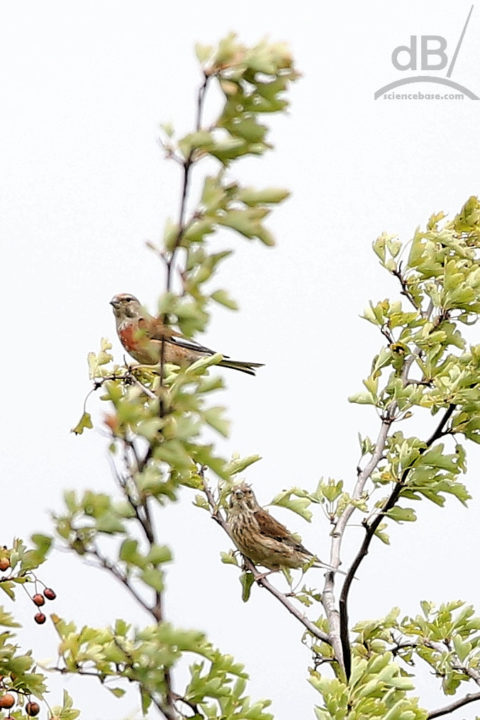Don’t often see avian couples together…or more to the point, I don’t often catch them “on film” together. Here are Mr and Mrs Linnet (Linaria cannabina) at their residence in Rampton Pocket Park a few miles north of Cambridge. The bird’s English name comes from the species’ fondness for flax seed from which we make linen, the second part of its scientific name from its liking for hemp seed (Cannabis sativa). The bird is found across Europe into western and central Siberia and is non-breeding in north Africa and southwest Asia.
As you can hopefully see from my not particularly sharp photo the species is sexually dimorphic (the male and female are different): the male in summer has a red breast, grey nape, and red head-patch, while the females and juveniles lack the red colouring and have white underparts, with a buff-speckled breast.

Originally, the linnet was placed in the genus Carduelis, putting it squarely in with a finch grouping within the Fringillidae. Indeed, the linnet rather resembles the chaffinch and its high-pitched call (not always a “linnet-linnet-linnet”) resembles the jangling coins sound of the goldfinch. However, DNA evidence suggests that the linnet is not of the same genetics as the Carduelis finches and that it is on its own branch of the taxonomic tree of life. Hence, it is now in its own genus, Linaria, meaning linen weaver from the Latin.
There are several sub-species of Linaria cannabina in different parts of the world:
L. c. autochthona – Scotland
L. c. bella – Middle East to Mongolia and northwestern China
L. c. mediterranea – Iberian Peninsula, Italy, Greece, northwest Africa and Mediterranean islands
L. c. guentheri – Madeira
L. c. meadewaldoi – western Canary Islands (El Hierro and Gran Canaria)
L. c. harterti – eastern Canary Islands (Alegranza, Lanzarote and Fuerteventura)